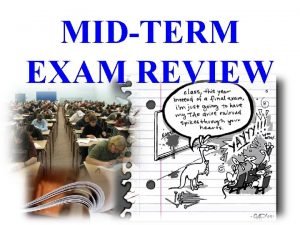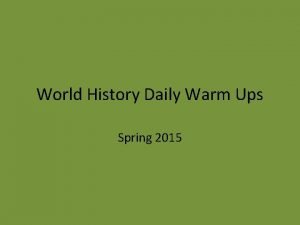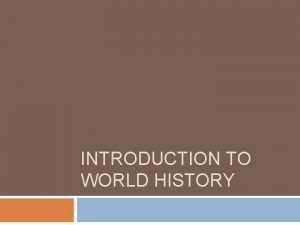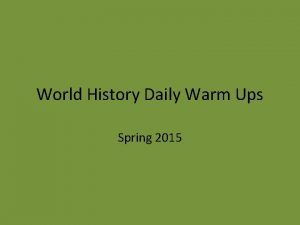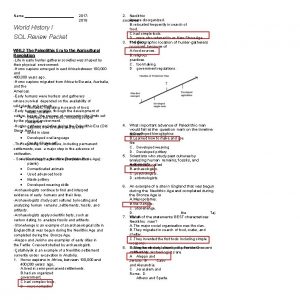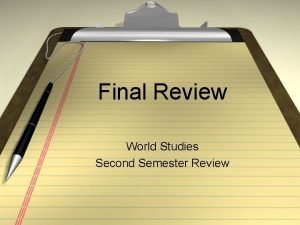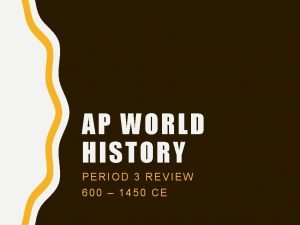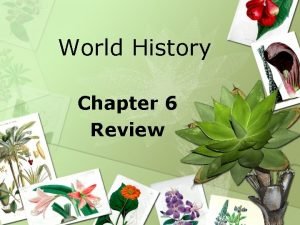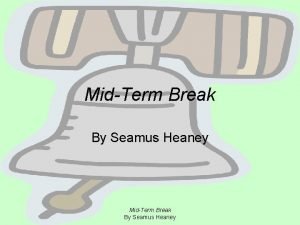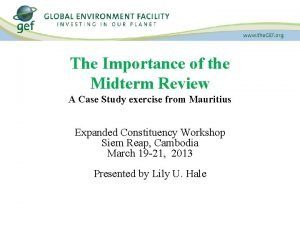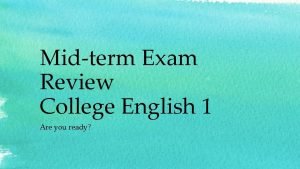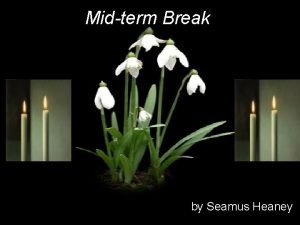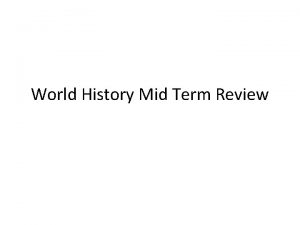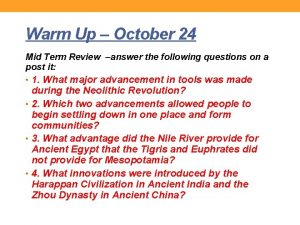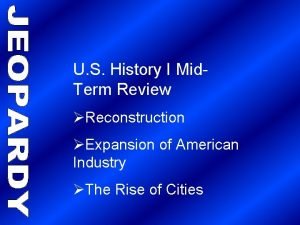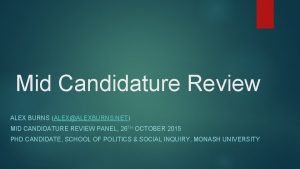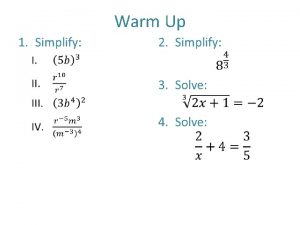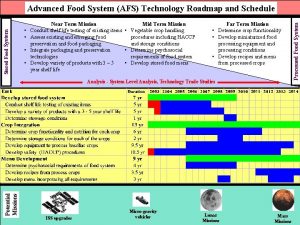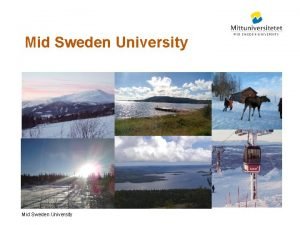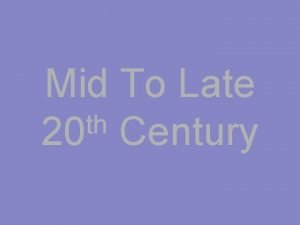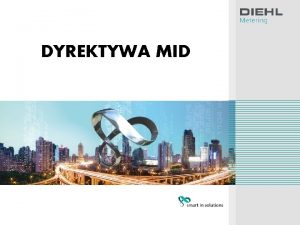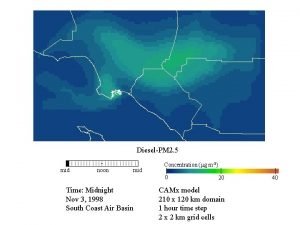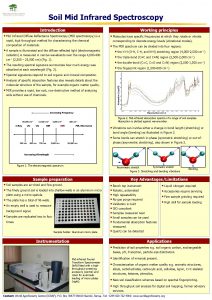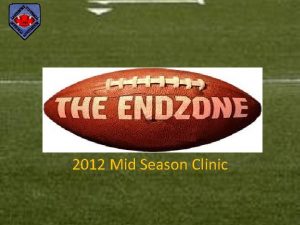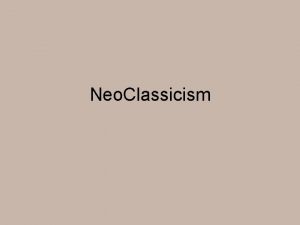World History Mid Term Review WARM UP 1










































- Slides: 42

World History Mid Term Review

WARM UP 1. Why were the Tigris and Euphrates Rivers important geographic features in the survival of the civilization in Mesopotamia? 2. What was an important factor that contributed to Neolithic civilizations being able to settle in one place? 3. What was an advantage that the Nile River provided for Egypt?

Mid Term Review 1. Why were the Tigris and Euphrates Rivers important geographic features in the survival of the civilization in Mesopotamia? (A) The rivers were natural barriers that helped to prevent outsiders from entering the civilization (B) The rivers helped to make the land fertile and ideal for agriculture (C) The rivers flooded like clockwork making farming conditions easy to predict (D) The rivers allowed for easy transportation to Asia

2. During the Neolithic Revolution, production of a food surplus led directly to: (A) a nomadic lifestyle (B) a reliance on stone weaponry (C) an increase in population (D) a dependence on hunting and gathering

3. One important factor that contributed to Neolithic civilizations being able to settle in one place was: (A) The hunting and gathering of plants and animals (B) The invention of stone tools (C) The domestication of animals (D) The conquering of other civilizations

4. One advantage that the Nile River provided for Ancient Egypt that the Tigris and Euphrates did not provide for Mesopotamia was: (A) It served as a natural barrier that prevented invasions and conquests (B) It rarely flooded (C) It was very short and easy to maintain (D) It was only used for transportation and did not have too many people using it

5. All of the following can be concluded about the Code of Hammurabi EXCEPT: (A) The laws favored the government over regular people (B) The laws favored regular people over the government (C) The laws discriminate against poorer people and women (D) the laws regularly used the death penalty as a consequence for committing a crime

6. The most remarkable achievement by the Harappan Civilization was their innovation in: (A) Irrigation Systems (B) City Planning (C) Winding Streets (D) Farming Equipment

7. One major cultural difference between Ancient India and Mesopotamia and Egypt was: (A) Ancient India did not rely on rivers for agriculture (B) Ancient India was ruled by an absolute ruler while Mesopotamia and Egypt were theocracies (C) Ancient India did not have large social class divisions while Mesopotamia had very structured social classes (D) Ancient India did not have natural barriers while both Mesopotamia and Egypt did

8. The Zhou Dynasty in China used a system of ruling where families controlled different regions of the country. This type of rule is known as: (A) Theocracy (B) Monarchy (C) Feudalism (D) Dynasty

9. Beginning in the Neolithic Revolution, production in food began to result in: (A) Bigger populations (B) Increased Warfare within civilizations (C) Decreased populations (D) Decreased interaction with other cultures

10. When two cultures exchange ideas or products thru conquest and trade, it is known as: (A) Cultural Diffusion (B) Cultural Transfusion (C) Cultural Exchange (D) Cultural Interaction

WORLD RELIGIONS REVIEW 11. A follower of Islam is called: • A. Brahman • B. Missionary • C. Muslim • D. Hindu

12. The founder of Islam is: • A. Siddhartha Guatama • B. Abraham • C. Jesus • D. Muhammed

13. Which is NOT one of the Five Pillars of Faith associated with Islam? • A. Give to charity • B. Pray 5 x's per day facing Mecca • C. Travel to Mecca at least once in your lifetime • D. Become a missionary in a foreign land

14. The sacred text (holy book) for followers of Islam is ________ • A. Bible • B. The Vedas • C. Qu' ran or Koran • D. The Torah

15. Judaism, Christianity, and Islam all ______________. • A. Believe in many divine Gods • B. Worship only one God • C. Follow the teachings of the Qu'ran • D. Believe Jesus was the son of God

16. The belief that the soul never dies but is continually reborn or reincarnated is associated with which religion? • A. Islam • B. Christianity • C. Judaism • D. Hinduism and Buddhism

17. Following the Eightfold Path and the Four Noble Truths to achieve enlightenment is associated with which religion? • A. Buddhism • B. Hinduism • C. Islam • D. Christianity

18. This religion can be divided into Catholic, Protestant, and Orthodox sects. • A. Judaism • B. Christianity • C. Islam • D. Buddhism

19. Ramadan is the holy month of fasting for which religion? • A. Christianity • B. Hinduism • C. Islam • D. Buddhism

20. This religion believes that the main god and creator, Brahman, takes the form of three deities. There are hundreds of other gods in this religion. What religion is this? • A. Judaism • B. Hinduism • C. Islam • D. Buddhism

21. The Ancient Greek city-state of Sparta: • (A) Was primarily concerned with the health of their people • (B) Was a powerful military state • (C) Granted universal suffrage to their people • (D) Placed great emphasis on literature and the arts

22. Which statement most likely represents the view of a citizen of ancient Athens visiting Sparta? • (A) I've never been in a place where they worship one god • (B) Sparta is so strict, people have little say in society • (C) This society allows more freedom of expression • (D) It is like I never left home

23. What was one effect of Alexander the Great's conquests? • (A) Decreased importance of the Silk Roads • (B) Formation of the Christian church • (C) Increased support of the Mayan leaders (D) Expansion of Hellenistic culture

24. An important factor that prevented the ancient Greek city-states from uniting to form a single nation was the: • (A) Lack of a common language • (B) Size of the desert regions • (C) Mountainous topography of the region • (D) Cold, hostile climate

25. Which organization did the ancient Greeks form in order to protect themselves against foreign invasions after the Persian War? • (A) The Peloponnesian League • (B) The Republic • (C) Sparta • (D) The Delian League

26. The Peloponnesian War was fought between: • (A) Two groups of Greek adversaries under the leadership of Athens and Sparta • (B) Thebes and Corinth • (C) Anatolian Greeks and peninsular Greeks • (D) The Persian Empire and Athens

27. The group that settled on the Italian Peninsula and influenced the Roman Civilization by bringing its lust for killing was: • (A) The Greeks • (B) The Etruscans • (C) The Latins • (D) The Romans

28. The Patricians in Rome were: • (A) Merchants, Artisans, Farmers • (B) Slaves, Women • (C) Beggars, Peasants • (D) Wealthy Landowners

29. What is the significance of Rome’s defeat of Carthage in the Punic Wars? • (A) Allowed them to spread Hellenistic Culture • (B) Allowed Rome to expand its empire across the Mediterranean • (C) Allowed the Germanic peoples to plan their invasion • (D) Allowed Scipio to become Emperor

30. Which ruler had the three goals of strengthening democracy in Greece, strengthening the Greek empire, and glorifying Athens? • (A) Pericles • (B) Themistocles • (C) Alexander The Great • (D) Phillip II

Unit 4 Review 31. During Feudalism: A. Trade was minimal and people lived in rural locations B. There was a lot of trade and people lived in cities C. There was a strong centralized government D. There was a lot of trade fairs

32. Serfs were people who: A. Own the land B. Protect the land C. Work the land D. Run the land

33. The Renaissance started in Northern Italy and can best be describe as a revival of: A. Art, Literature, Music, and Learning B. Religion C. Movement to reform the Roman Catholic Church D. Protestantism

34. Four major artists of the Renaissance include: A. Shakespeare, Calvin, Luther, Edward II B. Luther, Calvin, Raphael, Donatello C. Raphael, Donatello, Michaelangelo, Leonardo da Vinci D. Shakespeare, Calvin, Raphael, Donatello

35. A major innovation during the Hundred Years War was the invention of the: A. Musket B. Cannon C. Spear D. Longbow

36. The church that the Reformation movement sought to change was the: A. Protestant Church B. Roman Catholic Church C. Baptist Church D. Calvinist Church

37. Humanism focuses on: A. Human potential and achievement B. Religious themes C. Political and Economic themes D. Potential of a society

38. The two civilizations that influenced the Renaissance were: A. Rome and Carthage B. India and China C. Rome and Greece D. Greece and Persia

39. A man who excels in many things is known as a: A. Revolutionary man B. Renaissance man C. Reformer D. Multi-tasker

40. The Magna Carta was created by the nobles with the purpose of: A. Reducing the King’s power over the nobles B. Increasing the King’s power over the nobles C. Identifying the reasons that the colonists wanted to be independent of British rule D. Increasing nobles’ power over the peasants
 Mid term review format
Mid term review format World history warm up questions
World history warm up questions World history warm ups
World history warm ups World history warm up questions
World history warm up questions World history spring final exam review answers
World history spring final exam review answers World history 1 sol review packet
World history 1 sol review packet World history semester 2 final review packet
World history semester 2 final review packet World history regular semester 1 review
World history regular semester 1 review 1450*3
1450*3 Hellenistic doctors increased their knowledge by
Hellenistic doctors increased their knowledge by World history fall final review answers
World history fall final review answers World history semester 1 final exam study guide answers
World history semester 1 final exam study guide answers Ap world history jeopardy review game
Ap world history jeopardy review game World history final exam study guide
World history final exam study guide Ap world history chapter 25 africa and the atlantic world
Ap world history chapter 25 africa and the atlantic world Bad dangerous tour
Bad dangerous tour Midterm presentation
Midterm presentation Mid term break conclusion
Mid term break conclusion Euro btp future
Euro btp future Importance of mid term evaluation
Importance of mid term evaluation Happy mid term break
Happy mid term break English 1 midterm exam answers
English 1 midterm exam answers Mid-term break
Mid-term break Mid term break summary
Mid term break summary Mid year budget review
Mid year budget review Mid year budget review
Mid year budget review Texas history warm ups
Texas history warm ups Us history warm up questions
Us history warm up questions Short term planning and long term planning
Short term planning and long term planning Term-to-term rule
Term-to-term rule Long term memory vs short term memory
Long term memory vs short term memory Nth term of ap
Nth term of ap Example of short term human resources
Example of short term human resources Term to term rule
Term to term rule Difference between long term and short term liabilities
Difference between long term and short term liabilities Difference between long term and short term liabilities
Difference between long term and short term liabilities Minterm maxterm
Minterm maxterm Rules in finding the nth term
Rules in finding the nth term Term to term rule
Term to term rule Long term goals
Long term goals Short term finance planning
Short term finance planning Chapter review motion part a vocabulary review answer key
Chapter review motion part a vocabulary review answer key Writ of certiorari ap gov example
Writ of certiorari ap gov example
